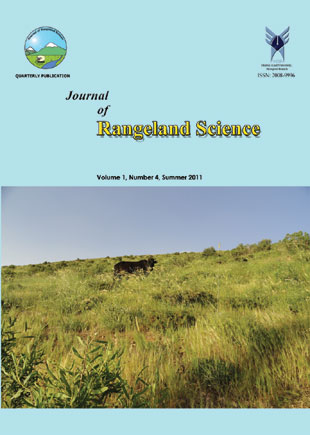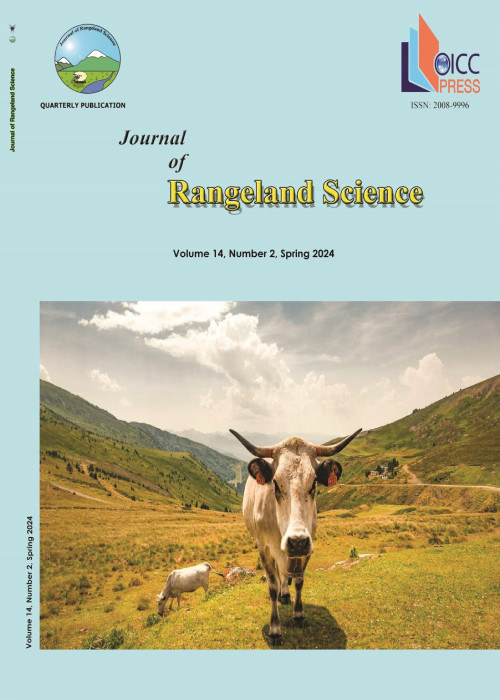فهرست مطالب

Journal of Rangeland Science
Volume:1 Issue: 4, Summer 2011
- تاریخ انتشار: 1390/11/03
- تعداد عناوین: 9
-
Page 255Vegetation cover over time and space is the result of interactions between vegetation cover and environmental factors. Changes occurred in range covers are caused by matrix dominance, one of the most important environmental factors. Decision support system (DSS) could be used for determining the rate and importance of each factor. Actually, in methods based on DSS, relations between input and output factors are identified. Up to now, various methods have been used in analyzing multivariate decision that includes binary comparison method that has been used in this study. This method has become one of the most commonly used methods of multivariate decision making and has been used for resolving unstructured issues in various human areas such as agriculture and natural sciences. In this study, nine sites were selected in west of Isfahan, Iran, then different vegetation cover and environmental factors were examined in each of these sites. By analyzing maincomponents, effective factors and impact of range were identified, finally using analytical hierarchical pattern (AHP) model, the quantity of effective factors on Yellow Astragalus and grass sites was determined. The rate of limestone of soil and slope factor in Yellow Astragalus were 14.4 and 14.2%, respectively, which have the greatest effect and with regard to grass transmittal, Soil limestone and soil acidity influenced 20 and 13.2% of variation, respectively.
-
Page 263In this paper, two formulas were chosen among those that estimate the suspended sediment discharge in rivers. These two formulas were Lane and Kalinske and Bagnold. For studying and knowing the correlation between input parameters and calculated suspended sediment discharge (CSSD), the SPSS17 software was used. Input parameters in these two formulas were as: water velocity, water discharge, suspended sediment concentration, hydraulic radius, and depth. By entering input parameters of these formulas into model, the results of both methods showed no significant correlation between CSSD and input parameters except water discharge in Lane and Kalinske and water velocity in Bagnold. Other input parameters have no good correlations with CSSD. Therefore, if Lane and Kalinske suspended sediment concentration and water discharge multiplied by each other and then equation powered by 0.5, the correlation between this equation and CSSD become better than supposing them individually with CSSD.
-
Page 269Floristic studies are fundamental for the applied sciences such as rangeland management and conservation. Unique ecological and climatic conditions in the Northern Khorasan Province (NKP) make it a remarkable habitat for the floristic studies. Plant species were collected from 50 field sites, representing major habitats of winter and rural rangelands. Surveys were conducted during active growth periods in 2007 and 2008. Plant species were identified and their chorology and life form determined through laboratory examinations and by using reference books. Floristic surveys resulted in identification of 534 plant species, belonged to 315 genus and 68 families. Asteraceae, Poaceae and Fabaceae were respectively the most abundant plant families. Among the life forms, Hemicryptophytes, Therophytes, Chamaephytes, Phanerophytes and Geophytes included 45, 32, 9, 7 and 7% of the total species, respectively. Irano-Turanian was the most dominant (65%) Chorotypes. The dominance of Hemicryptophytes and Therophytes, as well as vast distribution of Chamaephytes, can be referred to the simultaneous effects of climate fluctuations and livestock grazing on the flora of winter and rural rangelands in NKP.
-
Page 285To reach the desirable ecosystem management, determining the animal diet selection, which is one of the components of rangeland ecosystem, is important. Therefore, in order to determine the grazing behavior and diet selection of sheep and goat, the upland rangeland of northern part of Alborz was selected. In this study, the first weeks of July and August of 2009 were chosen for the grazing period of the animals. Range value and rangetrend method and the help of trend balance determined the range conditions and plant compositions in these two periods. Using the bite counting method, the grazing behavior of animals (sheep and goat) was observed from 0.5-2m via half an hour focus on each one and completing hundred records. Data collected and analyzed through the analysis of variance. Results showed that the bite counting method is a useful tool for determining the diet selection of sheep and goat. The animals have selected different layers of vegetation cover; therefore, range conditions have an effective role on the diet selection of animals within a grazing period. It has also shown that consumption rate was different in daily grazing in which sheep preferred to graze the forbs and goat browsed the bushy tree and shrub species if the grazing conditions were normal without any tension. Knowledge of the conditions of animals’ diet selection in each area could have an effective role on the production of rehabilitation and development programs.
-
Page 295MPSIAC is currently known as an appropriate method to measure sediment ofWatershed basins of the country while there has not been any sensitivity analysis so far forthis method. In this study, required data for MPSIAC model were gathered from six basins; Amame-Kamarkhani, Kand-Golandok, Tang Kenesht (from two different references), Nojian (from three different references), Pegahe sorkh katvand (from one reference) and Ivanaki (authors’ research). Eleven sensitivity analyses were conducted and the amount ofsediment was calculated using the sum of nine factors. Each input parameter was increased or decreased by 20% using a computer program in Visual Basic in Excel. Then sensitivity of the model for the parameters was analyzed. The less sediment has the basin, the less sensitivityhas the input parameters in the model. MPSIAC model has twenty input variables that resulted in nine main factors. Erosion parameter (R) was calculated by adding nine main factors and the quantity of sediment was calculated by an exponential function. By evaluation of nine main factors, it was concluded that land use and Gully development were the most sensitive factors. As a result, based on the area and sensitivity of main factors, more investments must be done on the most sensitive factor to reduce soil erosion. In the assessment of nine main factors occurred errors are reduced due to adding operation. Regarding all items, each factor that has more input quantity has the highest sensitivity. As a result, if score of each factor grows more than six, more attention must be paid to score assignation. If occurred errors in assessment of nine factors did not neutralize each other and have additive or decreasing on the R, by addition of 20% to R, it showed that this factor was the most sensitive factor to run the model. If R is equal to 60 and 20% related to the error occurred in calculation of it, 54% error occurs in estimating the amount of sediment and sensitivity reaches to 2.7. This evaluation indicated that MPSIAC model for evaluation of basins with the amount of sediment more than 2.2 ton/hectare must be used more preciously because the model is so sensitive in this status and possible error may get over 50%.
-
Page 303At the beginning of twenty-first century, the water crisis in the priority policy and management is inside and outside of the country as principle thoroughly human, social, economic and political rulers of the country is considered abundant. The World Bank has announced that during 1960 and 2025, water resources in Middle East, from 3430 m3 for the each person in year reach to 667 m3 because of population growth, degradation of natural resources, extent and spread of deserts. Study of ecohydrology in arid and semi arid rangelands of the world is one of the newest methods for available water resource management. In this science, all of effective ecology elements on water balance equation werereviewed. In these areas, a strong relation had been seen between ecology and hydrology processes. In these areas, not only lack of precipitation, but also irregular and unpredictabledistribution of precipitation was problematic. Ecohydrology pays particular attention to these areas of vegetation and its impact on groundwater and surface water.
-
Page 309Converting the native rangelands to simplified agronomic communities causes some changes in soil carbon, nitrogen and phosphorus. Establishing of perennial plantcommunities on formerly cultivated rangelands is expected to stabilize soil properties and increase the amount of C, N, P stored in rangeland soils, but there is little information on what plant communities are the most effective for improvement of soil C, N, P reserves. The purpose of this study was to compare soil C, N, and P pools in ungrazed native rangelandswith plant community of Festuca-Centurea with those ungrazed pastures established by sowing non-native perennial grasses (Agropyron elongatum and Agropyron desertorum), shrubs (Kochia prostrata), and wheat cultivation in continuous dry land farming system. Study site was located in Sisab Research Station in North Khorasan Province, Iran. The results showed that the total C, N and P contents in the soils under modified plant communities were less than that for native rangeland. Soils under A. elongatum, A. desertorum and K. prostrata tended to have higher values for total C, N and P than soils cultivated annually in wheat-fallow systems. The total C and N content of soils under K. prostrata were near as native rangeland which suggests that K. prostrata can increase the soil C and N contents much more rapidly than the other perennial communities.
-
Page 317Mountainous rangeland ecosystems have a highly delicate position in ecologic area because of severe environmental conditions and having wildlife and livestock. Knowing and realizing the biotic and abiotic components, which have an interaction with each other in this ecosystem, perform the most important role in to desirable management of it. The systematic management is one of the managing features such as modern approach for land management and suitable use of upland ecosystems. To reach that, mountainous rangelands of Javaherdeh (Ramsar) via 1:25,000 scale map were selected. Density, rangeland conditions, vegetation cover, gravel and grit were determined by Superficial and modified six-factor methods, Arc GIS v.9.3 software was employed to achieve land form map which was obtained by the combination of altitude, slope, and slope aspect maps. First, basic and first environmental unit maps were changed with land form map into soil type map, and first basic map intovegetation type map. The proposal map of systematic management of area was associated with final environmental unit map into landuse map via their attribute table. The established proposal map shows accurate position of different future land uses on the basis of current ecological capabilities of areas. Around Javaherdeh village is suitable for extensive outdoor recreation (7.59%) and appropriate for the grazing of livestock (62.22%). Some areas (20.07%) also should be protected because of landslides and debris formation.
-
Page 331Desertification is one of the major issues threatening human communities. Many methods have been developed for assessment and mapping of desertification hazards. In this research, multi-criteria evaluation method was used to investigate desertification process in Trouti watershed, Golestan Province, Iran. At the first step, major desertification factors were determined by doing field surveys. They were soil texture, aspect, rainfall, sensitivity of geological formation to erosion, hydrologic soil group, slope and land use. The next step, information layers were digitized in GIS environment and Digitized maps were converted to fuzzy standard maps using fuzzy membership functions in IDRISI software. Then, weight of each factor was determined with the contribution of Analytical Hierarchy Process. Finally, the susceptible areas to desertification in the study area were identified using Multi-criteria evaluation method. The results showed that 36.55, 15.21, 40.17 and 8.07 % of the study area were classified as severe, high, moderate and slow affected by desertification, respectively. It was concluded that land use and sensitivity of geological formations to erosion were the most important factors affecting desertification process in Trouti watershed of Golestan Province.


